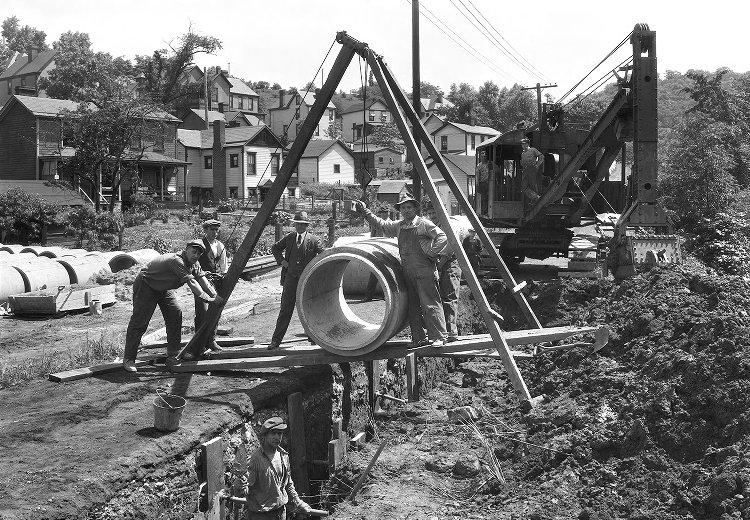 Crews installing a sewer pipe in 1926
Crews installing a sewer pipe in 1926
Our first sewer lines were built as early as 1840 in present-day Shadyside and Oakland. By 1908, more than 390 miles of underground sewer lines were in place, establishing the start of our combined sewer system that is still used today. Our sewer system includes 1,200 miles of sewer lines and more than 25,000 storm drains.
We send wastewater – the water you flush down your toilet or water that goes down your drain to ALCOSAN, the regional wastewater treatment plant along the Ohio River. They treat wastewater for the 83 municipalities in Allegheny County, including the City of Pittsburgh.
Approximately 75 percent of the sewer system is a combined system, meaning that stormwater and wastewater flow through the same pipe. The remaining 25 percent is a separated system, which means that wastewater flows through one sewer pipe and stormwater flows through another.
While sewers serve a simple purpose – to move sewage and stormwater away from homes and businesses – a sewer failure can be very impactful. When sewer walls crack or collapse, they can cause sinkholes, sewer backups, and sewage service impacts to our customers. Additionally, full sewer replacements can be a costly and time-consuming project. This is why PWSA is focusing a majority of its approximately $189 million capital plan over the next four years to proactive sewer work. This involves sewer rehab, that repairs small cracks and debris without a trench, and sewer relocation from risky locations like under railroad tracks or on steep hillsides.
To ensure sewer and stormwater service for all our customers, we must ensure that our sewers have structural integrity and are free of debris. Our primary sewer projects are as follows:
- Sewer Rehabilitation Projects: We will use extensive televised footage collected of our sewer to determine which portions of sewer can be proactively rehabbed before they fail. This work is done without a trench, using sewer lining technology. Sewer liners are a sleeve that is cured to the inside of the pipe, creating a protective barrier that secures cracks in the pipe and prevents leaks.
- Sewer Under Structures: Sewers that have been built underneath structures - which includes buildings, bridges, or railroads – can be an even bigger risk when they fail due to their location. For this reason, we have committed to identifying those locations and creating a new pipe design that is located in public space or in a safer place. PWSA’s engineering team will work with land owners to make necessary adjustments and avoid costly and disruptive sewer failures in the future.
- Sewer Reconstruction: We must be ready to respond to emergency sewer situations that cause flooding, basement back-ups, and other quality of life issues that impact customers.
- Large Diameter Sewer Rehabilitation: Our largest sewers in the system, which are responsible for carrying large volumes of sewage and stormwater, require special attention. For the next four years, we will address these sewers 36-inches and above, restoring structural integrity, removing roots, and repairing cracks that may cause infiltration into the pipe. Through this work, we will also collecting important televised footage of our largest sewer mains.
- 31st Ward Sewer Project: The 31st Ward Project has already started, and will be phased over the next four years to improve the quality of our sewers in the Lincoln Place Neighborhood. This project involves sewer rehabilitation using sewer lining, some sewer excavation, and rehabilitation work at two of our sewer pump stations in the area. For more, visit the project page.
How To Handle A Sewer Backup
It's never pleasant, but on occasion basements and sewers back up into homes and business throughout Pittsburgh. When this happens, you'll want to know what to do and who to call. Take the time to prepare by reading these helpful steps for handling a sewer backup.
Follow Your Flush!
ALCOSAN, 3 Three Rivers Wet Weather, and CivicMapper created the Flush It! tool. The tool shows the path wastewater takes to the ALCOSAN treatment facility from any address within their service area. Enter your address to follow your flush to ALCOSAN.
